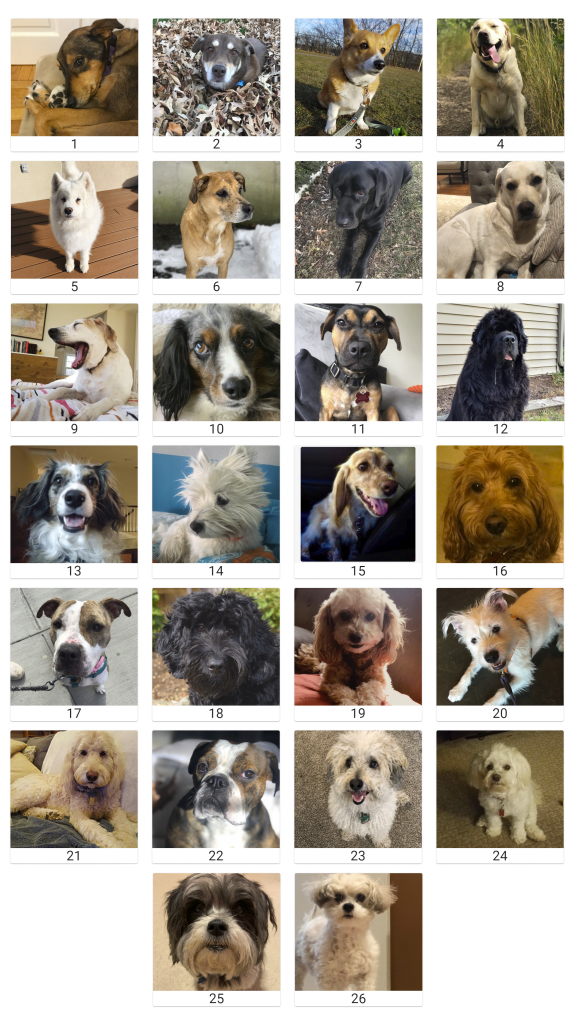The Cute Dog Project
A group of undergraduates at Northeastern University studying philosophy, political science, computer science, data science, economics, and other subjects teamed up on a surprisingly interesting and sophisticated project to rank the cutest dog in the university’s Department of Philosophy and Religion.
Called The Cute Dog Project, it attempted to address “a topic about which there has been long-standing and passionate disagreement” in “a philosophically and scientifically rigorous way.”
(This is how we start weeks in the summer time, people. With cute dogs.)
They write:
One reputable method of settling disputes in judgement is to vote. We decided to run a vote to settle whose dog is cutest in the Philosophy & Religion Department (students, faculty and staff) at Northeastern. However, answering the deceptively simple question of “Who has the cutest dog?” actually requires answers to several other difficult questions in the areas of democracy, ethics, and social choice, such as:
- How can democratic processes be used fairly to resolve disputes?
- What would our voting procedure be?
- How do we balance user accessibility, voter anonymity, and security in an online voting system?
- How do we define cuteness, and what voting mechanisms work to identify that definition?
- Who would be allowed to submit photos and who would be allowed to vote?
- How does this question help us uncover answers about generalized social choice theories and voting procedures?
- How do we control for possible social and cultural biases in a way that allows us to accurately represent people’s true preferences?
- How do we collect and manage voting data in ways that are secure, ethical, and respect the privacy of the voters?
Determining whose dog is the cutest required us to design a system informed by democratic theory, social choice theory, information ethics, value theory, critical theory, and philosophy of science. We had to grapple with the same sorts of issues that arise in democratic practice and social decision-making in other contexts—for example, selecting a presidential candidate from a crowded primary field or selecting applicants for admission to a competitive university.
Voting was open from April 3 to April 22, where almost 60,000 votes were submitted by almost 1,000 unique voters. After the contest, we used a social choice method called Ranked Pairs to identify the winner. The winner of the contest was Pearl!
You can explore their site to learn the details of the project, meet the team members, and explore the concept of cuteness.
Interested in settling who has the cutest dog in your department? Or cuddliest cat? Or spikiest hedgehog? One of the team members, Julian Zucker, wrote to me:
I noticed that there were no open-source libraries that allow people to easily run social choice mechanisms on vote sets. So, I made one! I hope it can be useful to other philosophers and students who are implementing voting systems in practice.
He also wrote in with a query:
As part of the dog project, we collected pairwise preferences (Dog A is cuter than Dog B), and eventually we wanted to run Borda count* on the dogs. However, Borda count is position-based, and so you have to convert the pairwise preferences to an ordering. With this real-world dataset, some of the preference sets were incomplete (not covering all dogs) or intransitive. I searched for ways to convert pairwise vote sets into orderings, but couldn’t find any papers on the subject. Have you heard about this, or know where I could research further/who I could ask about it?
Readers, perhaps you could help out with this?
(*apparently first developed by Nicholas of Cusa.)





THEY’RE ALL GOOD DOGS, BRENT
I find the premise deeply objectionable! Why would we ever be forced to set up a hierarchy of dog cuteness?
Look into the eyes of Dog #10 and tell me that you can contemplate comparing his absolute worth to the worth of any other dog.
There’s a metaphysical problem here that looms large as well. I am melting at #9 while yawning. Is he that cute when he’s not yawning? Are we talking cuteness at a time, cuteness over time, idealized cuteness detached from any details? Do we evaluate all the dogs’ properties? What about the smelly dog with the soulful eyes? What about the flatulent dog? Why are we limiting this project to visual characteristics?
I can’t help but look at #22 and #25 and reconsider any hubristic impulse to rank these dogs. And I strongly urge the Northeastern philosophy department to do so as well.
I don’t see the need to convert the individual pairwise preference sets into ranked lists. A lot of voting methods (most “Condorcet methods”) that normally take ranked lists as input actually use these ranked lists to generate matrices of pairwise overall preferences (i.e. matrices telling you who would win if any two candidates were running against each other). Such matrices can also be generated directly from the individual pairwise preference sets and then be used according to these methods. Wikipedia has a list of such methods: https://en.wikipedia.org/wiki/Condorcet_method#Single-method_systems.
If you really want to convert the individual preference sets into ranked lists, you could use the same methods, by treating each individual preference set as a separate election where there is only one voter.
Great post; love the engagement with social choice.
There is no general way to convert any set if pairwise preferences into an ordering since, as your post notes, pairwise preferences may be intransitive (even if we stipulate that they are complete, ie that xRy or yRx for all x, y). So I take it your post is not asking about conditions to guarantee the existence of the ordering (which are given by the definition of an ordering) but rather about how to actually construct the ordering. In other words, given a set of pairwise preferences that are complete, reflexive, transitive, and complete, is there some nice algorithm for turning a set of the pairwise preferences into an ranked list of the options?
If you have finitely many options, you can ask: which options are weakly preferred to all possible options? By Lemma 1*L of Sen’s 1970 Collective Choice and Social Welfare, such an option will exist. The set of all such options can be understood to be “ranked first” in the ordering. Then, take the set of options excluding those things that are ranked first (ie the complement of the first-ranked options) and repeat: which options are weakly preferred to all other remaining options. Again, the same reasoning leads us to conclude that some options will be so preferred to all other remaining options. Repeat; since we have finitely many options, the process will terminate.
This is not very elegant, though. There are probably less computationally demanding ways to get an answer.
They are all so cute I want one.